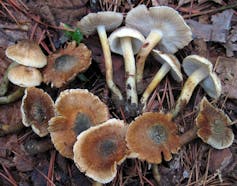Magic mushrooms have been used in traditional ceremonies and for recreational purposes for thousands of years. However, a new study has found that mushrooms evolved the ability to make the same psychoactive substance twice. The discovery has important implications for both our understanding of these mushrooms' role in nature and their medical potential.
Author
- Fabrizio Alberti
Associate Professor in Life Sciences, University of Warwick
Magic mushrooms produce psilocybin, which your body converts into its active form, psilocin, when you ingest it. Psilocybin rose in popularity in the 1960s and was eventually classed as a Schedule 1 drug in the US in 1970, and as a Class A drug in 1971 in the UK, the designations given to drugs that have high potential for abuse and no accepted medical use. This put a stop to research on the medical use of psilocybin for decades.
But recent clinical trials have shown that psilocybin can reduce depression severity, suicidal thoughts and chronic anxiety. Given its potential for medical treatments, there is renewed interest in understanding how psilocybin is made in nature and how we can produce it sustainably.
The new study , led by pharmaceutical microbiology researcher Dirk Hoffmeister, from Friedrich Schiller University Jena, discovered that mushrooms can make psilocybin in two different ways, using different types of enzymes. This also helped the researchers discover a new way to make psilocybin in a lab.
Based on the work led by Hoffmeister, enzymes from two types of unrelated mushrooms under study appear to have evolved independently from each other and take different routes to create the exact same compound.
This is a process known as convergent evolution, which means that unrelated living organisms evolve two distinct ways to produce the same trait. One example is that of caffeine , where different plants including coffee, tea, cacao and guaraná have independently evolved the ability to produce the stimulant.
This is the first time that convergent evolution has been observed in two organisms that belong to the fungal kingdom. Interestingly, the two mushrooms in question have very different lifestyles. Inocybe corydalina, also known as the greenflush fibrecap and the object of Hoffmeister's study, grows in association with the roots of different kinds of trees. Psilocybe mushrooms, on the other hand, traditionally known as magic mushrooms, live on nutrients that they acquire by decomposing dead organic matter, such as decaying wood, grass, roots, or dung.

The observation that mushrooms that inhabit two different niches make the same psychedelic compound raises questions regarding the ecological role of this molecule. A possible explanation as to why both mushrooms produce psilocybin could be that it is intended to deter predators, such as insects, that may be tempted to eat their fruiting bodies. This would be similar to the role of caffeine, which is also known to act as a natural pesticide , deterring insects and other pests from feeding on certain plants.
Turning discovery into opportunity
This study may provide scientists with additional tools to produce psilocybin to use for medical purposes. Mushrooms tend to grow slowly both in nature and in the laboratory. Psilocybe (magic mushrooms) take about two months to grow from spores to mature mushrooms.
If large amounts of psilocybin are needed for testing in clinical trials or for future medical use, quick and sustainable ways of producing it should be investigated. Currently, psilocybin is produced using synthetic material because it is faster than extracting the compound from mushrooms and has higher yields. This has its drawbacks though. The current synthetic extraction methods that scientists use generate hazardous waste and include key steps that can only be carried out on a small scale.
In a separate study published in April 2025, Hoffmeister and his coworkers came up with a new approach to produce psilocybin. His team used enzymes derived from fungi to catalyse the reactions to make psilocybin, rather than a fully synthetic approach, which uses lab-made materials and catalysts. This approach can be carried out on a larger scale than the usual, fully synthetic method. The immobilised enzymes they used are also reusable, making the process more sustainable.
Enzymes are inherently more sustainable than non-biological catalysts because they generally operate in mild conditions (such as low temperature and neutral pH) and are easier to purify, which reduces energy consumption and waste. Also, enzymes are biodegradable, which helps decrease the environmental impact of industrial processes.
Hoffmeisters' most recent work provides the scientific community with additional enzymes that can be used to make psilocybin.
While we can only speculate as to why different mushrooms would come up with alternative ways of making the same psychedelic compound, this discovery opens new avenues for the large-scale production of a promising candidate drug.
![]()
Fabrizio Alberti receives funding from UKRI through grants MR/V022334/1, BB/X018369/1 and EP/X039587/1, and from the British Council through grant 1203466293.






